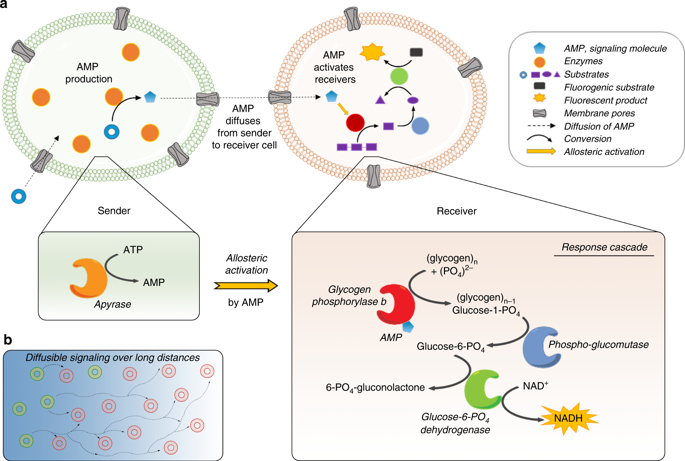Nature Communications ( IF 14.7 ) Pub Date : 2020-04-03 , DOI: 10.1038/s41467-020-15482-8 Bastiaan C Buddingh' 1, 2 , Janneke Elzinga 3 , Jan C M van Hest 1, 2, 4

|
Multicellular organisms rely on intercellular communication to coordinate the behaviour of individual cells, which enables their differentiation and hierarchical organization. Various cell mimics have been developed to establish fundamental engineering principles for the construction of artificial cells displaying cell-like organization, behaviour and complexity. However, collective phenomena, although of great importance for a better understanding of life-like behaviour, are underexplored. Here, we construct collectives of giant vesicles that can communicate with each other through diffusing chemical signals that are recognized and processed by synthetic enzymatic cascades. Similar to biological cells, the Receiver vesicles can transduce a weak signal originating from Sender vesicles into a strong response by virtue of a signal amplification step, which facilitates the propagation of signals over long distances within the artificial cell consortia. This design advances the development of interconnected artificial cells that can exchange metabolic and positional information to coordinate their higher-order organization.
中文翻译:

通过分子信号的变构放大实现人工细胞之间的细胞间通讯。
多细胞生物依靠细胞间通讯来协调单个细胞的行为,从而实现细胞的分化和分层组织。人们已经开发出各种细胞模拟物,以建立构建显示细胞样组织、行为和复杂性的人造细胞的基本工程原理。然而,集体现象虽然对于更好地理解类生命行为非常重要,但尚未得到充分探索。在这里,我们构建了巨大囊泡的集合,它们可以通过扩散化学信号相互通信,这些化学信号被合成酶级联识别和处理。与生物细胞类似,接收囊泡可以通过信号放大步骤将源自发送囊泡的微弱信号转导为强响应,这有利于信号在人工细胞群内长距离传播。这种设计促进了互连人工细胞的发展,这些细胞可以交换代谢和位置信息以协调其高阶组织。









































 京公网安备 11010802027423号
京公网安备 11010802027423号